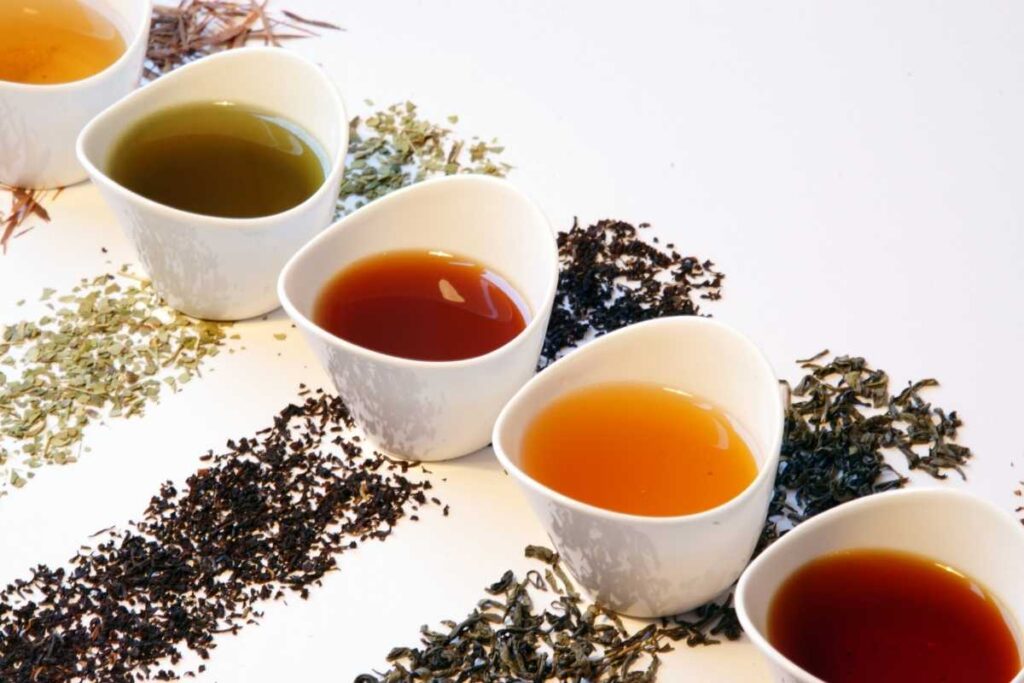Tea Types: Your Ultimate Comprehensive Guide

Welcome to the world of tea types! Tea is one of the most widely consumed beverages in the world, and it comes in many different varieties. Tea types are categorized based on the region where they are grown and processed, giving each type a unique profile and processing method. In addition to traditional teas, there are also herbal teas, green teas, purple teas, and dark teas available for those who want to explore more options.
English Breakfast is a popular type of tea among tea drinkers worldwide. The name of a tea type can give insight into its profile and processing methods. For example, English Breakfast is a blend of black teas from various regions, including Assam, Ceylon, and Kenya. Other popular types of tea include herbal tisanes, oolongs, matcha, and yerba mate.
So how many types of tea are there? Well, it depends on who you ask. Some sources say there are six main types: green tea, black tea, white tea, oolong tea, pu-erh tea, and herbal tea. Others might categorize them differently or include additional types such as dark teas and purple teas. However, it’s important to note that true teas only include green, black, white, oolong, and pu-erh teas. And let’s not forget about matcha – a type of powdered green tea that has gained popularity in recent years.
Regardless of how you categorize them, each type has its own unique flavor profile and health benefits. Green tea is known for its high antioxidant content and fresh taste. Black tea is often stronger and more robust than other types. White tea is delicate with a subtle flavor profile. Herbal teas, purple teas, and oolong teas have their own distinct taste and health benefits. Additionally, herbal tisanes are a great caffeine-free option with various flavors to choose from.
But it’s not just about taste – the way that different teas, such as herbal tisanes, matcha, oolong, and rooibos, are processed can also impact their health benefits. For example, pu-erh teas undergo microbial fermentation during processing which some studies suggest may have cholesterol-lowering effects.
Tea drinkers around the world enjoy experimenting with different types of teas to find their favorites. And with so many popular varieties available from all corners of the globe – from Chinese oolong to Indian chai and South African rooibos – there’s always something new to try.
Camellia Sinensis Tea Plant and its Varieties
Camellia Sinensis is the tea plant species used to produce most types of tea, including green teas, herbal teas, oolong teas, and matcha. There are two main varieties of Camellia Sinensis: sinensis and assamica. These plants are grown in various regions worldwide, including China, Sri Lanka, and Yunnan Province.
White tea, along with green teas and oolong teas, are all true teas that come from the Camellia Sinensis plant in China. White tea is made from young leaves and buds, while green tea is made from more mature leaves. Oolong tea is partially fermented, giving it a unique flavor profile. Chamomile tea, on the other hand, comes from the chamomile plant flowers and is known for its calming effects.
Black tea and green tea are two popular varieties of true teas that come from the Camellia Sinensis plant. China is one of the major producers of these teas. Oolong teas, another type of true tea, also come from this plant, but undergo a partial oxidation process, resulting in a unique taste and caffeine content.
Oolong tea is popular varieties made by partially oxidation the leaves of the Camellia Sinensis plant before drying them. This process, also known as erh, gives it a unique flavor profile that falls somewhere between green and black teas.
Purple tea is one of the popular varieties of tea that originates from Kenya. It gets its name from its purple-colored leaves caused by high levels of anthocyanins (a type of antioxidant). Purple teas have a mild taste with hints of floral notes.
Red bush tea, also known as rooibos, comes from the Aspalathus linearis plant in South Africa. It has no caffeine content and has a sweet, nutty flavor profile that makes it popular among those who want to avoid caffeine or enjoy something different than traditional teas.
Yerba mate is a type of true tea made from the leaves of the Ilex paraguariensis plant in South America. It has an earthy flavor similar to green tea but with higher caffeine content. Pu enthusiasts may find yerba mate to be an interesting addition to their collection.
Different Types of Tea: A Comprehensive List
Tea is one of the most popular true teas in the world, and there are many different types to choose from, including green teas. Each type of tea has its own unique flavor, aroma, and health benefits. Here is a comprehensive list of the most popular types of tea:
- Black Tea: This is the most common type of true teas consumed in the Western world. It is made from fully oxidized leaves and has a bold, robust flavor. Pu-erh tea is a type of true tea that can also be enjoyed by tea enthusiasts.
- Green Tea: This type of true tea is made from unoxidized leaves and has a light, refreshing taste. It contains high levels of antioxidants that can help boost your immune system.
- White Tea: This tea is made from young leaves that are picked before they are fully matured. It has a delicate flavor and contains even higher levels of antioxidants than green tea.
- Oolong Tea: This type of tea is partially oxidized, giving it a unique flavor that falls somewhere between black and green teas.
- Herbal Tea: Unlike traditional teas which come from the Camellia sinensis plant, herbal teas are made by steeping herbs, fruits, or flowers in hot water. They come in a wide variety of flavors and have numerous health benefits depending on the ingredients used.
- Pu-erh Tea: This fermented tea comes from China’s Yunnan province and is known for its earthy flavor and potential health benefits such as aiding digestion.
There are also many other types of specialty teas available such as matcha (powdered green tea), chai (spiced black tea), rooibos (red bush) tea and more.
Benefits and Differences Between Various Types of Tea
Green tea, white teas, and black tea are some of the most popular types of tea in the world. Each type has its unique characteristics and reported benefits. Let’s take a closer look at these different types of tea.
Green tea is known for its high levels of antioxidants, which can help reduce the risk of chronic diseases such as cancer and heart disease. Antioxidants are compounds that protect cells from damage caused by free radicals. Green tea also contains caffeine, which can improve mental alertness and focus.
White teas are considered to be the least processed type of tea, which means they retain more of their natural health benefits. White teas contain a high concentration of catechins, which are antioxidants that have been shown to have anticancer properties. They also contain less caffeine than green or black teas.
Black tea contains caffeine, which can help improve mental alertness and focus. It also contains flavonoids that may help reduce the risk of heart disease by improving blood flow and reducing inflammation. Research has shown that regular consumption of any type of tea can lead to improved heart health over time.
It really depends on personal preference and desired health benefits. For example, if you’re looking for a low-caffeine option with high antioxidant content, white tea might be your best bet. If you need a boost in mental alertness but still want to reap some health benefits, green or black tea would be good options.
Steeping and Serving Different Varieties of Tea: A Beginner’s Guide
Brewing the perfect cup of tea can be a daunting task, especially if you’re just starting. But don’t worry! We’ve got you covered with this beginner’s guide to steeping and serving different varieties of tea.
First things first, it’s important to note that the steeping process for different tea types varies. For example, green tea should be steeped at a lower temperature than black tea. Water temperature is crucial in brewing tea as it affects the flavor and aroma of the final product.
Here are some general guidelines for steeping different types of teas:
- Black Tea: Boil water and let it cool down for a few minutes before pouring over your tea leaves. Steep for 3-5 minutes.
- Green Tea: Heat water until bubbles start to form on the bottom of the pot (around 175°F). Steep for 1-2 minutes.
- White Tea: Heat water until bubbles start to form on the bottom of the pot (around 160°F). Steep for 2-3 minutes.
- Oolong Tea: Boil water and let it cool down for a few minutes before pouring over your tea leaves. Steep for 4-7 minutes.
- Herbal Tea: Boil water and pour directly over your herbs or flowers. Steep for 5-10 minutes.
The order of pouring water and steeping time differs depending on each variety. For instance, when making Irish Breakfast, pour hot water over your teabag first before adding milk or sugar. On the other hand, growing teas like blooming teas require unique serving methods where they are presented in clear glass teapots so that their beautiful shapes can be appreciated.
There is also a range of techniques you can use to enhance the flavors of different tea varieties, which are produced from tea plants. The tea production process involves carefully selecting and plucking green tea leaves, which are then processed to create the various types of tea.
- Black Tea: Best served plain or with milk and sugar
- Green Tea: Best served plain or with a slice of lemon
- White Tea: Best served plain or with honey
- Oolong Tea: Best served plain or with a splash of milk
- Herbal Tea: Best served plain or with a teaspoon of honey
Storing your tea properly is also important in maintaining its quality. Keep your tea leaves in an airtight container away from direct sunlight, moisture, and strong odors.
While we’re on the topic of tea, have you ever wondered how to make different types of boba tea? It’s actually quite simple! All you need is some black tea, milk, sweetener, and tapioca pearls. Cook the pearls according to package instructions and add them to your sweetened black tea and milk mixture for a delicious treat!
Loose Leaf vs Tea Bags: Which One to Choose?
There are two main options: loose leaf or tea bags. While both can provide a delicious cup of tea, there are some differences that may make one option more appealing than the other.
Loose leaf tea uses whole or partially broken leaves, while tea bags contain smaller pieces or even powder. This means that loose leaf teas offer a wider variety of flavors and aromas compared to tea bags. Loose leaf teas are available in different grades, from light green to brown, while tea bags usually contain lower quality leaves.
While loose leaf tea requires a bit more effort to prepare, it provides a more authentic tea experience. Brewing loose leaf tea involves measuring out the desired amount of leaves and steeping them in hot water for a certain amount of time. This process allows the full flavor and aroma of the leaves to be released.
On the other hand, tea bags are more convenient and quicker to prepare, making them ideal for busy mornings. Simply place the bag in hot water and let it steep for a few minutes before removing it.
It’s important to note that not all teas are available in both loose leaf and bag form. Some specialty teas may only be available as loose leaf due to their unique processing methods or high quality.
In terms of cost, loose leaf teas tend to be more expensive than their bagged counterparts due to higher quality ingredients and packaging. However, many argue that the superior taste and experience is worth the extra cost.
Ultimately, whether you choose loose leaf or tea bags depends on personal preference and lifestyle factors such as time constraints and budget. Both options can provide a satisfying cup of tea – it just comes down to what works best for you.
So next time you’re deciding between loose leaf or bagged tea, consider your priorities – do you prioritize flavor over convenience? Quality over cost? Whatever your choice may be, sit back, relax, and enjoy a delicious cup of tea.
Flavors and Aromas of Different Teas
Tea is more than just a hot beverage; it’s an experience. The flavors and aromas of different teas can transport you to far-off lands, soothe your soul, or invigorate your senses. Understanding the various types of tea and their unique flavor profiles can help you choose the perfect brew for any occasion.
Black teas are bold and robust with a rich, full-bodied flavor. They are made from fully fermented tea leaves that have been oxidized to produce a dark color and strong taste. Assam, Darjeeling, and Ceylon are popular varieties of black tea that offer distinct flavor profiles.
Green teas are lighter in taste and color than black teas. They have a delicate, grassy flavor with subtle hints of sweetness or bitterness depending on the variety. Green tea leaves are not fermented but instead steamed or pan-fried to preserve their natural flavor. Sencha, matcha, and Dragonwell are some examples of green teas that offer unique aroma and taste.
Herbal tisanes offer a wide range of flavors without containing any actual tea leaves. Instead, they use herbs, flowers, fruits, or spices to create soothing blends that cater to individual preferences. Chamomile is known for its calming properties while peppermint offers refreshing notes.
Fermented teas like Pu-erh have an earthy flavor profile with hints of sweetness or bitterness depending on how long they were aged for fermentation process. Purple tea is another type of fermented tea which has health benefits thanks to its high levels antioxidants called anthocyanins.
Boba Tea or Bubble Tea is typically made using black tea as its base mixed with milk and sugar syrup along with tapioca pearls added in it which gives it chewy texture when consumed.
Understanding the World of Tea Types
Understanding the World of Tea Types is essential for any tea lover. With so many varieties of tea available, it can be overwhelming to choose the right one. From Camellia Sinensis Tea Plant and its Varieties to Loose Leaf vs Tea Bags, this blog post has covered all aspects of tea types. Different Types of Tea: A Comprehensive List provides a detailed overview of popular teas, while Benefits and Differences Between Various Types of Tea highlights their unique health benefits. Steeping and Serving Different Varieties of Tea: A Beginner’s Guide gives practical tips on how to brew and serve different teas. Flavors and Aromas of Different Teas explores the sensory experience of drinking tea.
Whether you prefer black, green, white, or herbal teas, there is something for everyone in the world of tea types. Each type has its own distinct flavor profile and brewing method that can enhance your overall tea-drinking experience.
Choosing between Loose Leaf vs Tea Bags can also make a significant difference in taste and quality. While tea bags offer convenience, loose leaf teas provide a more nuanced flavor profile that comes from using whole leaves.




